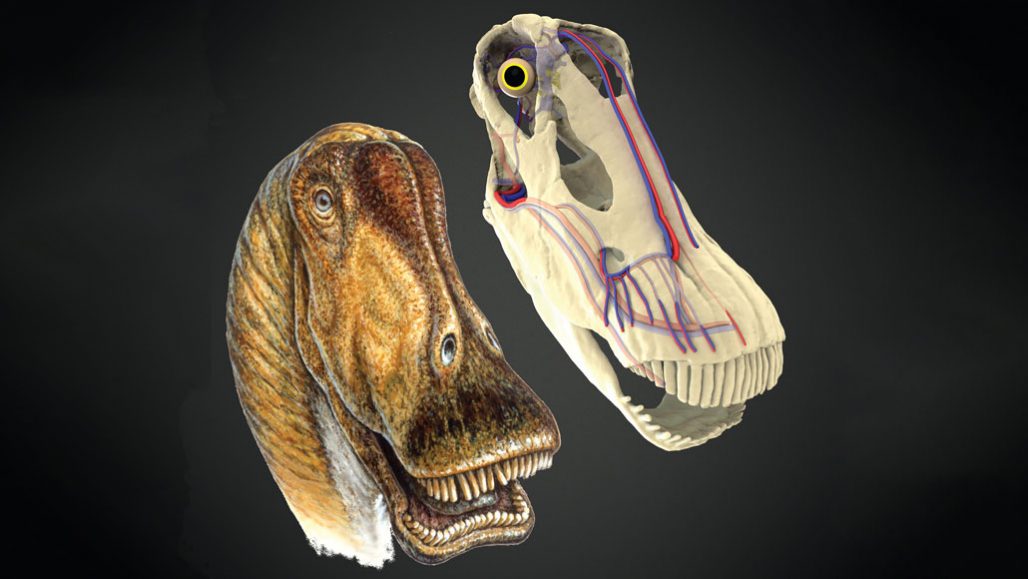3-D Short for three-dimensional. This term is an adjective for something that has features that can be described in three dimensions — height, width and length.
ankylosaurs Large, squat, tank-like dinosaurs that walked around on four legs. Spiked armor plates shielded their backs and flanks. One of the largest and best-known members of this family was Ankylosaurus, which grew to 10 metres (33 feet). A bony club on its tail was probably used as a defense against predators and competitors.
birds Warm-blooded animals with wings that first showed up during the time of the dinosaurs. Birds are jacketed in feathers and produce young from the eggs they deposit in some sort of nest. Most birds fly, but throughout history there have been the occasional species that don’t.
blood vessel A tubular structure that carries blood through the tissues and organs.
cavity (in geology or physics) A large rigid pocketlike structure. (in biology) An open region pocketlike structure surrounded by tissues.
core Something — usually round-shaped — in the center of an object.
dinosaur A term that means terrible lizard. These ancient reptiles lived from about 250 million years ago to roughly 65 million years ago. All descended from egg-laying reptiles known as archosaurs. Their descendants eventually split into two lines.
ecology A branch of biology that deals with the relations of organisms to one another and to their physical surroundings. A scientist who works in this field is called an ecologist.
evaporate To turn from liquid into vapor.
evolutionary An adjective that refers to changes that occur within a species over time as it adapts to its environment. Such evolutionary changes usually reflect genetic variation and natural selection, which leave a new type of organism better suited for its environment than its ancestors. The newer type is not necessarily more “advanced,” just better adapted to the conditions in which it developed.
fossil Any preserved remains or traces of ancient life. There are many different types of fossils: The bones and other body parts of dinosaurs are called “body fossils.” Things like footprints are called “trace fossils.” Even specimens of dinosaur poop are fossils. The process of forming fossils is called fossilization.
mammal A warm-blooded animal distinguished by the possession of hair or fur, the secretion of milk by females for feeding their young, and (typically) the bearing of live young.
muscle A type of tissue used to produce movement by contracting its cells, known as muscle fibers. Muscle is rich in protein, which is why predatory species seek prey containing lots of this tissue.
network A group of interconnected people or things. (v.) The act of connecting with other people who work in a given area or do similar thing (such as artists, business leaders or medical-support groups), often by going to gatherings where such people would be expected, and then chatting them up. (n. networking)
organism Any living thing, from elephants and plants to bacteria and other types of single-celled life.
paleontologist A scientist who specializes in studying fossils, the remains of ancient organisms.
reptile Cold-blooded vertebrate animals, whose skin is covered with scales or horny plates. Snakes, turtles, lizards and alligators are all reptiles.
sauropod A very large, four-legged, plant-eating dinosaur with a long neck and tail, small head and massive limbs.
sinus Air-filled cavities (known as sinus cavities) around the nose and eyes. The tissue lining the sinuses makes mucus. It collects foreign materials and helps it drain into the nose. A painful inflammation of these tissues is known as sinusitis, which can create intense facial pressure and headaches around the cheeks and eyes.
skull The skeleton of a person’s or animal’s head.
thermoregulation The control of body temperature — especially the temperature at an organism's core.
theropod A usually meat-eating dinosaur that belonged to a group whose members are typically bipedal (walk on two legs). They range from small and delicately built to very large.
tyrannosaur A line of meat-eating dinosaurs that began during the late Jurassic Period, about 150 million years ago. These species persisted into the late Cretaceous Period, about 65 million years ago. The best known member of these species: the late Cretaceous’ Tyrannosaurus rex, a 12-meter (40 foot) long top predator of its time.
vertebrate The group of animals with a brain, two eyes, and a stiff nerve cord or backbone running down the back. This group includes amphibians, reptiles, birds, mammals and most fish.
X-ray A type of radiation analogous to gamma rays, but having somewhat lower energy.








